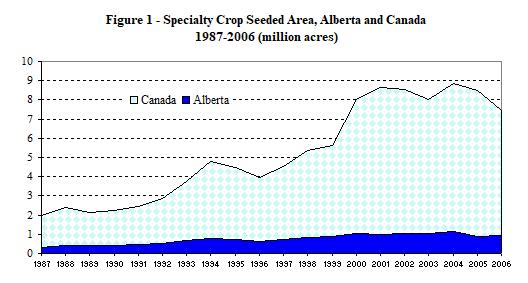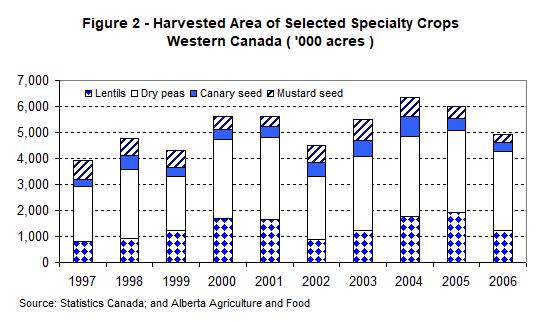| | Purpose of survey | Methodology | Survey results | Acknowledgments
...
Purpose of survey
To address some of the data and information needs of the specialty crop industry in Alberta, the Statistics and Data Development (SADD) Section conducts an annual Specialty Crop Survey. Now into its twenty-fourth year, the survey captures data on area, yield and production for specialty crops grown in the province.
Data gathered from the survey are used primarily to generate related provincial and sub-provincial estimates. In turn, these estimates are used to validate some of the Alberta estimates generated by Statistics Canada, as well as to provide industry and other stakeholders with benchmark statistics for some of the “new” and emerging crops.
Methodology
The Alberta Specialty Crop Survey, which is provincial in scope, collects data through a non-probability sampling procedure. In January 2007, survey questionnaires were mailed out to 3,243 specialty crop producers across the province. The questionnaires specifically asked survey participants to provide information on the type of specialty crop grown, area (seeded and harvested acres), yield and production for 2006. Survey participants were informed that participation in the survey was voluntary. Moreover, all individual responses would be kept confidential under the provisions of the Federal Statistics Act, as well as under the Provincial Freedom of Information and Protection of Privacy (FOIP) Act. As of April 30, 2007, a total of 842 questionnaires were returned. Of this total 735 were usable and partly formed the basis in the generation of the Alberta 2006 specialty crop estimates.
Survey responses received were reviewed for data completeness, validated and entered into an electronic database. The data was then subjected to some computerized analyses, the results of which were rolled up into group summaries, to preserve data confidentiality of individual survey respondents. In turn, the group summaries, in conjunction with consultations with provincial specialists of Alberta Agriculture and Food (AF), industry, and information from published sources (e.g. Statistics Canada) were used to generate the provincial and sub-provincial (Census Division) estimates, where appropriate.
It cannot be over emphasized that extensive consultation is done with AF’s provincial specialists and industry in the development of the provincial/sub-provincial estimates. Provincial specialists are acknowledged for their useful information and invaluable insights on crop conditions and yields, particularly when attempting to firm up some of the sub-provincial estimates generated from the survey. Similarly, administrative data on yield and crop area grown under private contracts also add value to the estimates.
It should be noted that the estimates are subject to error. Some of the possible sources of error include data coding, data entry and tabulation. Nonetheless, we believe that the statistics published in this report are reliable estimates for Alberta.
Survey Results
Area, Yield and Production in Alberta
In 2006, there were more acres seeded to specialty crops, compared to a year earlier. Total provincial seeded area, excluding potatoes and forage seeds, was estimated at 0.96 million acres (see Figure 1), up seven per cent, from 0.90 million acres in 2005. The increase in acreage was largely attributed to higher acres for dry peas and silage corn. Of the total seeded area in 2006, nearly 0.86 million acres or 89 per cent were harvested for grain. To offer some perspective, shown in Figure 3 on page 4 is the percentage distribution of specialty crop seeded acreage by crop type in 2006.
Regarding crop growing conditions in 2006, the hot, dry weather experienced in July caused significant deterioration in crop conditions and yield potentials. However, in southern Alberta, where moisture reserves were better compared to the rest of the province, average yields for most specialty crops grown on dryland were significantly higher than the 10-year averages. Some specialty crops grown under irrigation also benefited from the heat in July, producing record or near record yields.
In 2006, the provincial average yield for dry peas was 35.9 bushels per acre. This was about 16 per cent lower than in 2005, but one per cent above the 10-year average. With the majority of its acreage in southern Alberta, mustard seed had an average yield of 939 pounds per acre, or three per cent higher than in 2005, and 23 per cent above the 10-year average. For chickpeas, the average yield was estimated at 1,433 pounds per acre, slightly below the record yield of 1,442 pounds per acre in 2005. Setting a new record in 2006 was sugar beets, with a record yield of 26 tonnes per acre, or 31 per cent higher than a year earlier.

Source: Statistics Canada; and Alberta Agriculture and Food
Specialty Crops in Western Canada
Based on the inter-censal revisions released by Statistics Canada in August 2007, and results of the Alberta 2006 Specialty Crop Survey, total seeded and harvested acres for specialty crops in Western Canada in 2006 declined from a year earlier. The inter-censal revisions reflected changes made to crop production estimates for the period of 2002 to 2006, using the 2006 census data as a benchmark. Due mainly to a substantial increase in fodder corn production, total 2006 production of specialty crops in Western Canada jumped significantly from a year earlier. Fodder corn production more than doubled from a year earlier, setting a record in 2006. As well, production for grain corn, soybeans, dry beans and sugar beets showed large increases over 2005 levels.
In 2006, a marked decline in the total seeded area of specialty crops in Saskatchewan more than negated increases in other provinces in Western Canada. As a result, the total seeded area of specialty crops in Western Canada dropped to 6.75 million acres, or eight per cent below the 7.36 million acres in 2005. On a provincial basis, Saskatchewan with its 4.66 million acres accounted for 69 per cent of the total specialty crop seeded area in Western Canada, while Manitoba and Alberta accounted for 16 per cent and 14 per cent, respectively. Specialty crop seeded area in British Columbia was extremely small. Similar to seeded area, the total harvested area in Western Canada in 2006 was down seven per cent from a year earlier, to 6.45 million acres.
The four large specialty crops grown in Western Canada in 2006 were dry peas, lentils, canary seed and mustard seed. Together, these crops accounted for 75 per cent of the total seeded area of specialty crops. Dry peas, with a total seeded area of 3.12 million acres, was the largest specialty crop, representing 46 per cent of the Western Canada total. Lentils was next, with seeded acres totaling 1.28 million or 19 per cent of the total, while mustard seed and canary seed accounted for five per cent each. Shown in Figure 2 is the harvested area of the top four specialty crops in Western Canada. Statistics on seeded area and production for selected specialty crops are presented in Table 5 on page 15.

Acknowledgments
The Statistics and Data Development Section of Alberta Agriculture and Food (AF) wishes to thank all of the producers who participated in the Alberta 2006 Specialty Crop Survey conducted in the winter of 2006/2007. Without their cooperation and assistance, this report would not have been possible.
Several AF staff members have made significant contributions to the successful completion of this report. Those staff include Charlie Pearson of Market and Consumer Analysis Unit, Nabi Chaudhary of Economics Unit, and Kwesi Ampong-Nyarko and Zhixiong Zhang of Agriculture Research Division.
Special thanks go to Melodie Mynzak of Statistics and Data Development Section for conducting the survey, as well as other staff members, including Gail Atkinson, Guangzhi Liu, Marion Harry, Marian Elson, and Margaret McDonald, for their valuable assistance in the completion and dissemination of the report.
Contacts
For additional copies of this report, please contact:
Alberta Agriculture and Forestry
Economics and Competitiveness Branch
Statistics and Data Development Section
#300, 7000 -113 Street
Edmonton, Alberta T6H 5T6
Phone: 780-422-2887
Fax: 780-427-5220
For a complete copy of the report, please download the attached .pdf file. |
|